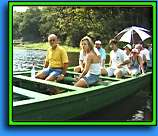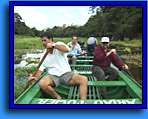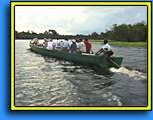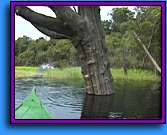| Go West, Passport To Knowledge!
 We got to play tourist a bit ourselves, strictly in the name of scouting,
of course. When the regularly scheduled excursion boat (a motorized and
pretty large canoe) left the dock later that afternoon, we followed them
in a “camera boat” of our own. Now the tourists were really getting value
for their vacation, especially when they got to cheer on the “American
TV Crew” as we gamely tried to free our boat from some particularly
enthusiastic weeds. Both Geoff and Brian had to wield paddles instead of computers, pens and camera. TV is definitely NOT all glamour!
We got to play tourist a bit ourselves, strictly in the name of scouting,
of course. When the regularly scheduled excursion boat (a motorized and
pretty large canoe) left the dock later that afternoon, we followed them
in a “camera boat” of our own. Now the tourists were really getting value
for their vacation, especially when they got to cheer on the “American
TV Crew” as we gamely tried to free our boat from some particularly
enthusiastic weeds. Both Geoff and Brian had to wield paddles instead of computers, pens and camera. TV is definitely NOT all glamour!
 The boat from the Ariau Towers does a good job of showing visitors an introduction to the surrounding area. There are small tributaries, rugged
jungle, partially flooded forests-it’s quite a shock to almost run into a
huge, gnarled, oak-like tree-on a boat!
The boat from the Ariau Towers does a good job of showing visitors an introduction to the surrounding area. There are small tributaries, rugged
jungle, partially flooded forests-it’s quite a shock to almost run into a
huge, gnarled, oak-like tree-on a boat!
 Alongside one bank of the river, both boats land on a wide beach and the
curious visitors are politely greeted by almost equally curious children.
No, we were not unexpected nor unwelcome guests-this turned out to be the
home of the pilot of one of the boats. Good-naturedly, his family living
in the stilt-legged house nearby shows us their small homestead. One large
tree has delicious purple berries, enough to share and more. The front
yard is taken up by a patch of “manioc”, a root vegetable which is the
Alongside one bank of the river, both boats land on a wide beach and the
curious visitors are politely greeted by almost equally curious children.
No, we were not unexpected nor unwelcome guests-this turned out to be the
home of the pilot of one of the boats. Good-naturedly, his family living
in the stilt-legged house nearby shows us their small homestead. One large
tree has delicious purple berries, enough to share and more. The front
yard is taken up by a patch of “manioc”, a root vegetable which is the staple of the regional diet. Manioc is used boiled, fried, or dried into
grains; it’s interesting for us to see where it comes from, seeing as how
not one of our meals has gone by in Manaus without at least one or two
forms of manioc being served.
staple of the regional diet. Manioc is used boiled, fried, or dried into
grains; it’s interesting for us to see where it comes from, seeing as how
not one of our meals has gone by in Manaus without at least one or two
forms of manioc being served.
This being the day for revelations, we also got the answer to another
trivia question: Where do Brazil nuts come from? Yes, of course, they come
from Brazil, but they don’t grow on trees individually, as you might
expect. We discovered the answer when one of our hosts at the homestead
set a large, coconut-looking fruit on a rock. With a machete, he gave the
fruit a terrific whack and split it into two halves. Ever notice how Brazil nuts have that distinctive wedge shape? It’s because they come in clusters
that fit inside the Brazil nut fruit, just like the sections of an orange.
Look closely at them next time you see them at the store, and see if you
can fit them together again.
nuts have that distinctive wedge shape? It’s because they come in clusters
that fit inside the Brazil nut fruit, just like the sections of an orange.
Look closely at them next time you see them at the store, and see if you
can fit them together again.
|
![]()
 We got to play tourist a bit ourselves, strictly in the name of scouting,
of course. When the regularly scheduled excursion boat (a motorized and
pretty large canoe) left the dock later that afternoon, we followed them
in a “camera boat” of our own. Now the tourists were really getting value
for their vacation, especially when they got to cheer on the “American
TV Crew” as we gamely tried to free our boat from some particularly
enthusiastic weeds. Both Geoff and Brian had to wield paddles instead of computers, pens and camera. TV is definitely NOT all glamour!
We got to play tourist a bit ourselves, strictly in the name of scouting,
of course. When the regularly scheduled excursion boat (a motorized and
pretty large canoe) left the dock later that afternoon, we followed them
in a “camera boat” of our own. Now the tourists were really getting value
for their vacation, especially when they got to cheer on the “American
TV Crew” as we gamely tried to free our boat from some particularly
enthusiastic weeds. Both Geoff and Brian had to wield paddles instead of computers, pens and camera. TV is definitely NOT all glamour!
 The boat from the Ariau Towers does a good job of showing visitors an introduction to the surrounding area. There are small tributaries, rugged
jungle, partially flooded forests-it’s quite a shock to almost run into a
huge, gnarled, oak-like tree-on a boat!
The boat from the Ariau Towers does a good job of showing visitors an introduction to the surrounding area. There are small tributaries, rugged
jungle, partially flooded forests-it’s quite a shock to almost run into a
huge, gnarled, oak-like tree-on a boat!
 Alongside one bank of the river, both boats land on a wide beach and the
curious visitors are politely greeted by almost equally curious children.
No, we were not unexpected nor unwelcome guests-this turned out to be the
home of the pilot of one of the boats. Good-naturedly, his family living
in the stilt-legged house nearby shows us their small homestead. One large
tree has delicious purple berries, enough to share and more. The front
yard is taken up by a patch of “manioc”, a root vegetable which is the
Alongside one bank of the river, both boats land on a wide beach and the
curious visitors are politely greeted by almost equally curious children.
No, we were not unexpected nor unwelcome guests-this turned out to be the
home of the pilot of one of the boats. Good-naturedly, his family living
in the stilt-legged house nearby shows us their small homestead. One large
tree has delicious purple berries, enough to share and more. The front
yard is taken up by a patch of “manioc”, a root vegetable which is the staple of the regional diet. Manioc is used boiled, fried, or dried into
grains; it’s interesting for us to see where it comes from, seeing as how
not one of our meals has gone by in Manaus without at least one or two
forms of manioc being served.
staple of the regional diet. Manioc is used boiled, fried, or dried into
grains; it’s interesting for us to see where it comes from, seeing as how
not one of our meals has gone by in Manaus without at least one or two
forms of manioc being served.
 nuts have that distinctive wedge shape? It’s because they come in clusters
that fit inside the Brazil nut fruit, just like the sections of an orange.
Look closely at them next time you see them at the store, and see if you
can fit them together again.
nuts have that distinctive wedge shape? It’s because they come in clusters
that fit inside the Brazil nut fruit, just like the sections of an orange.
Look closely at them next time you see them at the store, and see if you
can fit them together again.